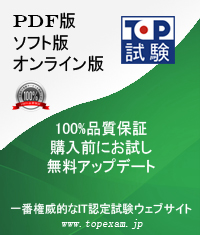質問 1:You manage a team of data scientists who use a cloud-based backend system to submit training jobs. This system has become very difficult to administer, and you want to use a managed service instead. The data scientists you work with use many different frameworks, including Keras, PyTorch, theano, scikit-learn, and custom libraries. What should you do?
A. Use the Vertex AI Training to submit training jobs using any framework.
B. Set up Slurm workload manager to receive jobs that can be scheduled to run on your cloud infrastructure.
C. Configure Kubeflow to run on Google Kubernetes Engine and submit training jobs through TFJob.
D. Create a library of VM images on Compute Engine, and publish these images on a centralized repository.
正解:A
解説: (Topexam メンバーにのみ表示されます)
質問 2:You work with a learn of researchers lo develop state-of-the-art algorithms for financial analysis. Your team develops and debugs complex models in TensorFlow. You want to maintain the ease of debugging while also reducing the model training time. How should you set up your training environment?
A. Configure a v3-8 TPU node.
B. Configure a c2-standard-60 VM without GPUs.
D, Configure a n1-standard-4 VM with 1 NVIDIA P100 GPU.
C. Configure a v3-8 TPU VM.
正解:C
質問 3:You are building a custom image classification model and plan to use Vertex Al Pipelines to implement the end-to-end training. Your dataset consists of images that need to be preprocessed before they can be used to train the model. The preprocessing steps include resizing the images, converting them to grayscale, and extracting features. You have already implemented some Python functions for the preprocessing tasks. Which components should you use in your pipeline'?
A.  B.
B.  正解:B
質問 4:
正解:B
質問 4:You are pre-training a large language model on Google Cloud. This model includes custom TensorFlow operations in the training loop Model training will use a large batch size, and you expect training to take several weeks You need to configure a training architecture that minimizes both training time and compute costs What should you do?
A.  B.
B.  C.
C.  D.
D.  正解:C
正解:C
解説: (Topexam メンバーにのみ表示されます)
質問 5:You work for a large hotel chain and have been asked to assist the marketing team in gathering predictions for a targeted marketing strategy. You need to make predictions about user lifetime value (LTV) over the next 30 days so that marketing can be adjusted accordingly. The customer dataset is in BigQuery, and you are preparing the tabular data for training with AutoML Tables. This data has a time signal that is spread across multiple columns. How should you ensure that AutoML fits the best model to your data?
A. Submit the data for training without performing any manual transformations Use the columns that have a time signal to manually split your data Ensure that the data in your validation set is from 30 days after the data in your training set and that the data in your testing set is from 30 days after your validation set
B. Submit the data for training without performing any manual transformations Allow AutoML to handle the appropriate transformations Choose an automatic data split across the training, validation, and testing sets
C. Manually combine all columns that contain a time signal into an array Allow AutoML to interpret this array appropriately Choose an automatic data split across the training, validation, and testing sets
D. Submit the data for training without performing any manual transformations, and indicate an appropriate column as the Time column Allow AutoML to split your data based on the time signal provided, and reserve the more recent data for the validation and testing sets
正解:D
解説: (Topexam メンバーにのみ表示されます)
質問 6:You work as an ML researcher at an investment bank and are experimenting with the Gemini large language model (LLM). You plan to deploy the model for an internal use case and need full control of the model's underlying infrastructure while minimizing inference time. Which serving configuration should you use for this task?
A. Deploy the model on a Google Kubernetes Engine (GKE) cluster manually by creating a custom YAML manifest.
B. Deploy the model on a Vertex AI endpoint manually by creating a custom inference container.
C. Deploy the model on a Google Kubernetes Engine (GKE) cluster using the deployment options in Model Garden.
D. Deploy the model on a Vertex AI endpoint using one-click deployment in Model Garden.
正解:A
解説: (Topexam メンバーにのみ表示されます)
弊社のGoogle Professional-Machine-Learning-Engineerを利用すれば試験に合格できます
弊社のGoogle Professional-Machine-Learning-Engineerは専門家たちが長年の経験を通して最新のシラバスに従って研究し出した勉強資料です。弊社はProfessional-Machine-Learning-Engineer問題集の質問と答えが間違いないのを保証いたします。

この問題集は過去のデータから分析して作成されて、カバー率が高くて、受験者としてのあなたを助けて時間とお金を節約して試験に合格する通過率を高めます。我々の問題集は的中率が高くて、100%の合格率を保証します。我々の高質量のGoogle Professional-Machine-Learning-Engineerを利用すれば、君は一回で試験に合格できます。
安全的な支払方式を利用しています
Credit Cardは今まで全世界の一番安全の支払方式です。少数の手続きの費用かかる必要がありますとはいえ、保障があります。お客様の利益を保障するために、弊社のProfessional-Machine-Learning-Engineer問題集は全部Credit Cardで支払われることができます。
領収書について:社名入りの領収書が必要な場合、メールで社名に記入していただき送信してください。弊社はPDF版の領収書を提供いたします。
弊社は失敗したら全額で返金することを承諾します
我々は弊社のProfessional-Machine-Learning-Engineer問題集に自信を持っていますから、試験に失敗したら返金する承諾をします。我々のGoogle Professional-Machine-Learning-Engineerを利用して君は試験に合格できると信じています。もし試験に失敗したら、我々は君の支払ったお金を君に全額で返して、君の試験の失敗する経済損失を減少します。
弊社は無料Google Professional-Machine-Learning-Engineerサンプルを提供します
お客様は問題集を購入する時、問題集の質量を心配するかもしれませんが、我々はこのことを解決するために、お客様に無料Professional-Machine-Learning-Engineerサンプルを提供いたします。そうすると、お客様は購入する前にサンプルをダウンロードしてやってみることができます。君はこのProfessional-Machine-Learning-Engineer問題集は自分に適するかどうか判断して購入を決めることができます。
Professional-Machine-Learning-Engineer試験ツール:あなたの訓練に便利をもたらすために、あなたは自分のペースによって複数のパソコンで設置できます。
一年間の無料更新サービスを提供します
君が弊社のGoogle Professional-Machine-Learning-Engineerをご購入になってから、我々の承諾する一年間の更新サービスが無料で得られています。弊社の専門家たちは毎日更新状態を検査していますから、この一年間、更新されたら、弊社は更新されたGoogle Professional-Machine-Learning-Engineerをお客様のメールアドレスにお送りいたします。だから、お客様はいつもタイムリーに更新の通知を受けることができます。我々は購入した一年間でお客様がずっと最新版のGoogle Professional-Machine-Learning-Engineerを持っていることを保証します。
Google Professional-Machine-Learning-Engineer 認定試験の出題範囲:
| トピック | 出題範囲 |
|---|
| トピック 1 | - Collaborating within and across teams to manage data and models: It explores and processes organization-wide data including Apache Spark, Cloud Storage, Apache Hadoop, Cloud SQL, and Cloud Spanner. The topic also discusses using Jupyter Notebooks to model prototypes. Lastly, it discusses tracking and running ML experiments.
|
| トピック 2 | - Serving and scaling models: This section deals with Batch and online inference, using frameworks such as XGBoost, and managing features using VertexAI.
|
| トピック 3 | - Monitoring ML solutions: It identifies risks to ML solutions. Moreover, the topic discusses monitoring, testing, and troubleshooting ML solutions.
|
| トピック 4 | - Automating and orchestrating ML pipelines: This topic focuses on developing end-to-end ML pipelines, automation of model retraining, and lastly tracking and auditing metadata.
|
| トピック 5 | - Scaling prototypes into ML models: This topic covers building and training models. It also focuses on opting for suitable hardware for training.
|
参照:https://cloud.google.com/certification/guides/machine-learning-engineer
TopExamは君にProfessional-Machine-Learning-Engineerの問題集を提供して、あなたの試験への復習にヘルプを提供して、君に難しい専門知識を楽に勉強させます。TopExamは君の試験への合格を期待しています。



 PDF版 Demo
PDF版 Demo











 品質保証TopExamは我々の専門家たちの努力によって、過去の試験のデータが分析されて、数年以来の研究を通して開発されて、多年の研究への整理で、的中率が高くて99%の通過率を保証することができます。
品質保証TopExamは我々の専門家たちの努力によって、過去の試験のデータが分析されて、数年以来の研究を通して開発されて、多年の研究への整理で、的中率が高くて99%の通過率を保証することができます。 一年間の無料アップデートTopExamは弊社の商品をご購入になったお客様に一年間の無料更新サービスを提供することができ、行き届いたアフターサービスを提供します。弊社は毎日更新の情況を検査していて、もし商品が更新されたら、お客様に最新版をお送りいたします。お客様はその一年でずっと最新版を持っているのを保証します。
一年間の無料アップデートTopExamは弊社の商品をご購入になったお客様に一年間の無料更新サービスを提供することができ、行き届いたアフターサービスを提供します。弊社は毎日更新の情況を検査していて、もし商品が更新されたら、お客様に最新版をお送りいたします。お客様はその一年でずっと最新版を持っているのを保証します。 全額返金弊社の商品に自信を持っているから、失敗したら全額で返金することを保証します。弊社の商品でお客様は試験に合格できると信じていますとはいえ、不幸で試験に失敗する場合には、弊社はお客様の支払ったお金を全額で返金するのを承諾します。(
全額返金弊社の商品に自信を持っているから、失敗したら全額で返金することを保証します。弊社の商品でお客様は試験に合格できると信じていますとはいえ、不幸で試験に失敗する場合には、弊社はお客様の支払ったお金を全額で返金するのを承諾します。( ご購入の前の試用TopExamは無料なサンプルを提供します。弊社の商品に疑問を持っているなら、無料サンプルを体験することができます。このサンプルの利用を通して、お客様は弊社の商品に自信を持って、安心で試験を準備することができます。
ご購入の前の試用TopExamは無料なサンプルを提供します。弊社の商品に疑問を持っているなら、無料サンプルを体験することができます。このサンプルの利用を通して、お客様は弊社の商品に自信を持って、安心で試験を準備することができます。
